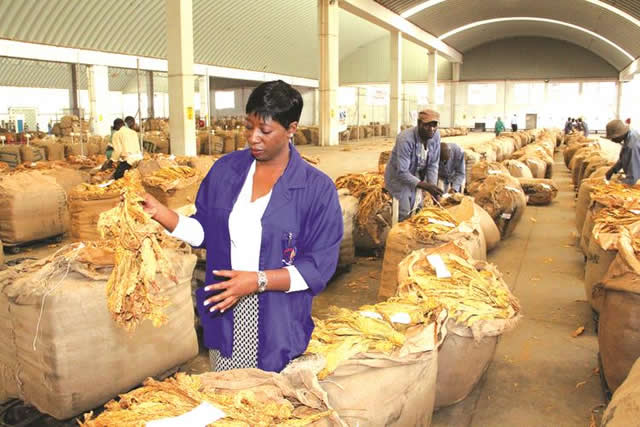Is Zimbabwe’s tobacco a ‘new diamond curse’?

My Two Cents
Curses don’t manifest immediately. It took Zimbabwe about six years for the diamond curse to be acknowledged. The tobacco industry in Zimbabwe is very unique. While the industry grew rapidly in the past 10 years, the regulators who maintain orderly marketing of the crop seem to have lost the plot on how to leverage the true potential arising from growth of this lucrative sector.The discovery of diamonds about a decade ago was largely greeted with a lot of enthusiasm and optimism that the mineral would anchor Zimbabwe’s economic development.
The sector was expected to create thousands of jobs, new infrastructural developments, and perhaps quality foreign investors would stampede for a piece of the cake. But as it turned out, all these were trinkets of deception.
Like the diamond industry, predicting gloom and doom in Zimbabwe’s tobacco industry may not make sense today in view of the fact that crop production spectacularly rebounded from a low of 50 million kilograms to the current production levels of around two hundred million kilograms.
This spectacular rebound in output can be attributed to a number of factors, key among them the land reform programme which allowed more people to participate in this lucrative industry.
Zimbabwe experienced its lowest tobacco output during a transitional period where agents of tobacco production were changing.
The other major reason why tobacco production rebounded is, unfortunately, the collapse of other vibrant agricultural sectors in Zimbabwe which include cotton, grains, horticulture, livestock, and many others.
Reasons for the demise of these sectors vary, but chief among them is cronyism, poor regulation, particularly for the cotton industry, conflicted regulators, and outright plunder of resources in a manner that eerily resonates with what happened to Zimbabwe’s diamonds.
We would not want to believe that the growth of the tobacco industry can be entirely attributed to the regulator, Tobacco Industry and Marketing Board.
While some want to give credit to the regulator, industry analysts believe it has performed below par in terms of discharging its roles. If fact, they believe a lot can be done.
Curses don’t manifest immediately. It took Zimbabwe about six years for the diamond curse to be acknowledged.
The tobacco industry in Zimbabwe is very unique. While the industry grew rapidly in the past 10 years, the regulators who maintain orderly marketing of the crop seem to have lost the plot on how to leverage the true potential arising from growth of this lucrative sector.
Indulging in incest with impunity!
It has been widely speculated and seriously thought that the regulator in one way or the other, could be seriously conflicted with people or companies it regulates. These alleged incestuous relationships could be floundered, and justified with impunity.
And probably this explains why the now defunct Millennium Tobacco Floors were issued with a licence despite clear evidence that they did not qualify. This may also explain the mushrooming of dubious tobacco contractors and buyers whose sole purpose is arbitrage.
For instance, regulations in the tobacco industry require ‘A’ class buyers to export over 90 percent of their purchases. However, a number of ‘A’ class buyers are getting licences when they do not have any export markets. In some cases, tobacco had been resold after leaving auction floors and higher prices paid. This has happened under the nose of the regulator. Going into the next season, the authorities should keep an eye on this!
We have also heard about companies converting levies paid by growers to their own use, but getting away with it. Recent reports indicate that Premier Tobacco Floors have done exactly that.
Let’s see what will happen.
Having said this, the regulator should be on the forefront of enforcing the regulations, without fear or favour. It will be suicidal to allow this sector, which is earning the country the huge foreign exchange to fall because of flawed regulatory enforcements.
As said earlier in this article, it must be remembered that poor regulatory enforcement contributed to the poor performance of the cotton industry and we do not want similar thing to happen.
Concerns have been raised over laxity of TIMB’s to control of side marketing yet in fact is supposed to raise stop signs. It must be remembered that at some point TIMB approved creation of multiple grower numbers used for arbitrage and side-marketing.
The justification then was that they were busting sanctions. Incredible! Players in the diamond industry played the “sanction-busting” mantra ad nauseam. We now know they were busting the fiscus, not sanctions. We now know they were not smacking ZDERA in the face, but the poor man from Marange, Chiadzwa, whose ancestral graves were destroyed in search of a gem that left aboard a looting plane.
Transparency — defunct, dead and buried!
The success story of land reform in tobacco has been well documented and is reflected by the normalisation of national production volumes to levels above 200m kg as well as the over 70 000 farmers who are now tobacco growers.
This success has not come without its fair share of challenges which have included environmental degradation as well as regulatory challenges. Tobacco is, arguably, the best performing sector in the country and as a result of this it has attracted a multitude of vendors and traders who are seeking to make a living along the tobacco value chain in defiance of established statutes.
The current liquidity constraints and the lack of financial inclusion has created an army of “vultures” who prey on the smallholder farmer either at the tobacco floors or by offering illegal sales of tobacco from the farm gate and loans advanced against the strength of illegal tobacco delivery.
The sheer numbers involved in tobacco production has created a huge challenge with respect to regulation of the orderly marketing of the crop.
As such, transparency in the tobacco industry seems to be now compromised. Zimbabwe used to be the model of tobacco marketing in the world, but that is now history.
Twenty five percent of the crop now determines pricing for 75 percent of the crop. Marketing of 75 percent of tobacco in Zimbabwe is done behind closed doors, allowing for segregation of farmers by race, level of education and well being.
Tobacco buyers are gradually pulling out of buying from auction floors in favour of buying behind closed doors.
Could TIMB be blind to the repercussions of this trend or they simply do not care?





Comments